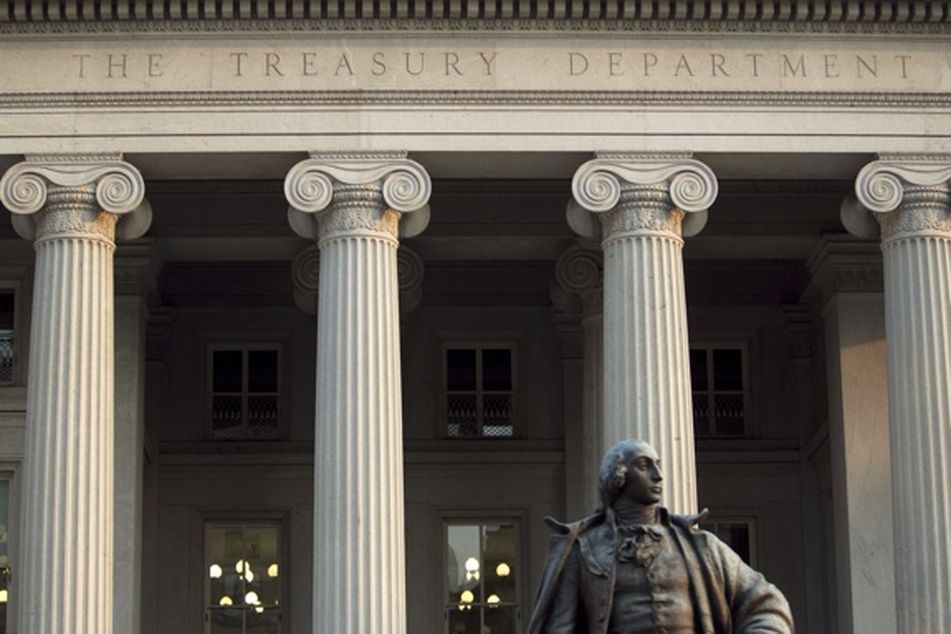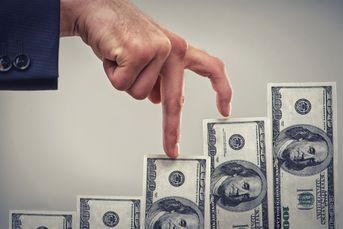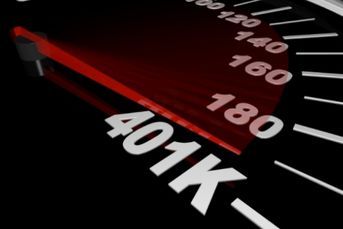Rating cut working out just fine for U.S. Treasury
 For Treasury Department, a one-tick wonder
For Treasury Department, a one-tick wonder
S&P's single-notch lowering of the U.S. sovereign debt rating was seen as a big blow to the Treasury market. Instead, worries about default on government debt has investors clamoring for -- yep -- government debt. The result? In an auction this week, taxpayers saved $647M.
The U.S. auctioned $72 billion of notes and bonds this week at the lowest average yield for a refunding on record, saving taxpayers $647 million in interest payments during the life of the securities less than a week after Standard & Poor’s removed the nation’s AAA rating.
The Treasury Department paid an average yield of 2.13 percent on the three-, 10- and 30-year securities, less than the previous refunding auctions in May of 3 percent and below the former record of 2.59 percent in February 2009, according to data compiled by Bloomberg. The government began selling 30-year bonds on a regular schedule in 1977 as part of its so-called quarterly refunding.
This week’s auction results show investors are repudiating S&P’s decision to lower its assessment of the U.S.’s creditworthiness to AA+, and are instead scooping up the debt on signs the economy and inflation are slowing and the near-zero chance the government will default. Moody’s Investors Service and Fitch Ratings have affirmed their AAA grades.
“One would be remiss to try and conclude that anyone is worried about that one-tick downgrade,” said Ian Lyngen, a government bond strategist at CRT Capital Group LLC in Stamford, Connecticut. “What is the yield differential in the market for that one tick? Apparently it’s nothing. If anything, it’s a bullish event for Treasuries.”
Demand Level
Demand for Treasuries is running at a level almost matching the record set last year when the government sold $2.249 trillion of notes and bonds, the most ever. Investors bid for 2.98 times the $1.317 trillion of securities sold in 2011, compared with 2.99 in 2010, Bloomberg data sold.
For all the conflict between Congress and President Barack Obama’s administration about the debt ceiling and deficits, bond investors say they are more influenced by interest rates, the economy and inflation. Because of the dollar’s pre-eminent place as the world’s reserve currency, the U.S. enjoys a “funding advantage,” S&P said in its Aug. 5 report.
The Federal Reserve boosted debt markets this week when it pledged to keep its target rate for overnight loans between banks at a record low of zero to 0.25 percent at least through mid-2013 to revive growth that it described as “considerably slower” than anticipated. Gross domestic product rose at a 1.3 percent annual rate in the second quarter, after expanding at a 0.4 percent pace in the prior three-month period, which was the weakest since the recovery began in June 2009.
‘Crowd Buying’
“We’ve joined the crowd buying Treasuries,” said Wan- Chong Kung, a bond fund manager Minneapolis at Nuveen Asset Management, which oversees more than $100 billion. “We recognize the heightened uncertainty and risk-off environment. The growth outlook has dimmed.”
This week’s auctions kicked off Aug. 9, when the U.S. sold $32 billion in three-year notes at a yield of 0.5 percent, the lowest since records began in May 1981. The bid-to-cover ratio was 3.29, exceeding the average of 3.15 in the prior 10 sales.
A day later the Treasury sold $24 billion of 10-year notes at a record low yield of 2.14 percent, below the average forecast of 2.199 percent in a Bloomberg News survey of nine of the Fed’s 20 primary dealers. The bid-to-cover ratio was 3.22, versus an average of 3.11 at the previous 10 sales. Indirect bidders, a class of investors that includes foreign central banks, bought 47.9 percent of the issue, the most since May 2010.
‘Huge Direct Bid’
The 10-year note sale “showed a lot of strength with the huge direct bid,” said Brian Edmonds, head of interest rates at Cantor Fitzgerald LP in New York, one of 20 primary dealers that are obligated to bid at Treasury auctions. “Treasuries are still the safe haven, until we’re not.”
Yesterday’s $16 billion sale of 30-year bonds bucked the trend, with the 3.75 percent yield being 13 basis points above the pre-auction estimate of 3.622 percent. Demand exceeded supply by 2.08 times, compared with the average of 2.64 at the past 10 sales.
“People didn’t show up for this one,” said Scott Sherman, an interest-rate strategist in New York at Credit Suisse Group AG, a primary dealer. “Increased worry about inflation has to get priced into the long bond, given the Fed’s accommodative stance. For now, there will be apprehension to buy that far out on the curve at these yield levels.”
Fall From High
Yields on 30-year bonds have fallen from this year’s high of 4.79 percent on Feb. 9. The securities have gained 17.7 percent this year, compared with a 7.08 percent return for Treasuries overall, according to Bank of America Merrill Lynch indexes.
In February 2009, when the record low for 30-year bond yields was set at a $14 billion offering at 3.54 percent, the Treasury sold $21 billion of 10-year notes at 2.819 percent and $32 billion of three-year securities at 1.419 percent.
Before the scope of the financial crisis expanded and threatened the U.S. financial system, increasing U.S. borrowing needs, refunding months had been the only time when the Treasury sold 10- and 30-year securities. Those maturities are only due in refunding months, and securities sold outside those months are so-called re-openings of previous issues.
S&P, in lowering its rating on the U.S., said the prolonged discussions about raising the $14.3 trillion debt ceiling and a resolution that was below the rating company’s target of $4 trillion in spending cuts merited the downgrade.
Debt Levels
“The primary focus remained on the current level of debt, the trajectory of debt as a share of the economy, and the lack of apparent willingness of elected officials as a group to deal with the U.S. medium term fiscal outlook,” the firm said.
S&P’s decision was criticized by Obama and investors including Warren Buffett, who said the U.S. should be rated “quadruple-A.” It was seized on by Republicans including presidential candidate Mitt Romney, who said the downgrade showed lack of confidence in the president.
Congress and Obama have agreed to $2.4 trillion of budget cuts during the next 10 years, threatening to restrain growth, with the majority of the cutbacks to be decided through bipartisan negotiations beginning later this year. Obama and House Republican leaders haven’t come closer to compromising on how to cut the federal deficit.
“Political leadership understands what’s at stake in terms of the economy, in terms of financial market stability,” said Kung at Nuveen Asset Management. “The road to deficit reduction will continue to be difficult and noisy and disconcerting to investors, but ultimately we can get to a benign outcome.”
–Bloomberg News–
Learn more about reprints and licensing for this article.






